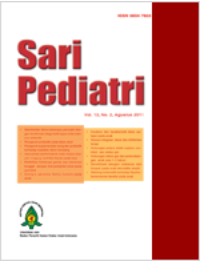Hubungan antara Faktor Risiko pada Ibu dan Kondisi Neonatus dengan Jumlah Eritrosit Berinti pada Neonatus Tunggal Cukup Bulan di RSUPN Dr Cipto Mangunkusumo
Sari
Latar belakang. Jumlah eritrosit berinti (EB) pada neonatus berpotensi menjadi prediktor kondisi
neonatus, seperti perlunya perawatan intensif. Hal tersebut belum pernah diteliti di RSUPN Cipto
Mangunkusumo.
Tujuan. Mengetahui hubungan antara faktor-faktor risiko pada ibu dan kondisi neonatus dengan jumlah
EB pada neonatus tunggal cukup bulan.
Metode. Studi potong lintang analitik pada neonatus tunggal cukup bulan dan ibunya antara bulan Maret
sampai Juni 2008 di Departemen Ilmu Kesehatan Anak FKUI – RSCM. Penghitungan jumlah EB dilakukan
pada sediaan apusan darah tepi yang diambil dari vena tali pusat dan dihitung per 100 leukosit.
Hasil. Didapatkan 117 pasang ibu melahirkan dan neonatus tunggal cukup bulan antara bulan April -
Mei 2008. Rerata usia ibu saat melahirkan adalah (28,9+6,38) tahun (rentang 17-42 tahun). Rerata usia
gestasi 38 minggu dan rerata berat lahir 3,051 g dengan rentang (1,900-4,100) g. Peningkatan jumlah
EB didapatkan pada 39,3% neonatus. Rerata jumlah EB (4,7+4,29) (0-22 EB) per 100 leukosit. Nilai
EB 4 memberikan sensitivitas dan spesifisitas terbaik, yaitu 73,3% dan 65,7% dengan area under the
curve (AUC) 0,771.
Kesimpulan. Terdapat hubungan bermakna antara riwayat ibu perokok pasif, nilai Apgar menit pertama
yang rendah, terdapat mekonium pada air ketuban, dan perawatan intensif neonatus dengan jumlah EB.
Peningkatan jumlah EB dapat dipakai untuk menentukan kemungkinan bayi akan mendapat perawatan
di ruang intensif. Penelitian lanjutan perlu dilakukan terhadap masing-masing faktor risiko kehamilan
dan persalinan terhadap jumlah EB untuk memahami patogenesis hipoksia pada neonatus sehingga dapat
direncanakan upaya-upaya preventif.
Kata Kunci
Teks Lengkap:
PDFReferensi
Perri T, Ferber A, Digli A, Rabizadeh E, Weissmann-
Brenner A, Divon MY. Nucleated red blood cells in
uncomplicated prolonged pregnancy. Obstet Gynecol
;104:372-6.
Hanlon-Lundberg KM, Kirby RS, Gandhi S, Broekhuizen
FF. Nucleated red blood cells in cord blood of singleton
term neonates. Am J Obstet Gynecol 1997;176:1149-
Hermansen MC. Nucleated red blood cells in fetus
and newborn. Arch Dis Child Fetal Neonatal Ed
;84:F211-5.
Phelan JP, Ahn MO, Korst LM, Martin GI. Nucleated
red blood cells: a marker for fetal asphyxia? Am J Obstet
Gynecol 1995;173:1380-4.
Ghosh B, Mittal S, Kuman S, Dadhwal V. Prediction
of perinatal asphyxia with nucleated red blood cells
in cord blood of newborns. Int J Gynecol Obstet
;81:267-71.
Gruslin A, Perkins SH, Manchanda R, Fleming N,
Clinch JJ. Maternal smoking and fetal erythropoietin
levels. Obstet Gynecol 2000;95:561-4.
Green DW, Mimouni F. Nucleated erythrocytes in
healthy infants and in infants of diabetic mothers. J
Pediatr 1990;116:129-31.
Korst LM, Phelan JP, Ahn MO, Martin GI. Nucleated
red blood cells: An update on the marker for fetal
asphyxia. Am J Obstet Gynecol 1996;175:843-6.
Ergin T, Tarcan A, Lembet A, Çetintas S, Çetintas S,
Haberal A. Nucleated red blood cell count in infants
of women with well-controlled gestational diabetes
mellitus. Artemis 2003;4:33-6.
Yeruchimovich M, Dollberg S, Green DW, Mimouni FB.
Nucleated red blood cells in infants of smoking mothers.
Obstet Gynecol 1999;93:403-6.
Littner Y, Mandel D, Sheffer-Mimouni G, Mimouni
FB, Deutsch V, Dollberg S. Nucleated red blood cells in
infants of mothers with asthma. Am J Obstet Gynecol
;188:409-12.
Hermansen MC. Nucleated red blood cells in fetus
and newborn. Arch Dis Child Fetal Neonatal Ed
;84:F211-5.
Minior VK, Bernstein PS, Divon MY. Nucleated red
blood cells in growth-restricted fetuses: Associations
with short-term neonatal outcome. Fetal Diagn Ther
;15:165-9.
Minior VK, Shatzkin E, Divon MY. Nucleated red blood
cell count in the differentiation of fetuses with pathologic
growth restriction from healthy small-for-gestational-age
fetuses. Am J Obstet Gynecol 2000;182:1107-9.
Dollberg S, Fainaru O, Mimouni FB, Shenhav M,
Lessing JB, Kupferminc M. Effect of passive smoking
in pregnancy on neonatal nucleated red blood cells.
Pediatrics 2000;106:1-3.
Hanlon-Lundberg KM, Kirby RS. Nucleated red blood
cells as a marker of acidemia in term neonates. Am J
Obstet Gynecol 1999;181:196-201.
Maier RF, Böhme K, Dudenhausen JW, Obladen M.
Cord blood erythropoietin in relation to different
markers of fetal hypoxia. Obstet Gynecol 1993;81:575-
Lim FTH, Schrjon SA, van Beckhoven JM, Brand A,
Kanhai HH, Hermans JMH, dkk. Association of stress
during delivery with increased numbers of nucleated
cells and hematopoietic progenitor cells in umbilical
cord blood. Am J Obstet Gynecol 2000;183:1144-51.
Blackwell SC, Hallak M, Hotra JW, Refuerzo J, Hassan
SS, Sokol RJ, dkk. Timing of nucleated red blood cell
count elevation in response to acute hypoxia. Biol
Neonate 2004;85:217-20.
DOI: http://dx.doi.org/10.14238/sp10.5.2009.345-50
Refbacks
- Saat ini tidak ada refbacks.
##submission.copyrightStatement##
##submission.license.cc.by-nc-sa4.footer##
Email: editorial [at] saripediatri.org


Sari Pediatri diterbitkan oleh Badan Penerbit Ikatan Dokter Anak Indonesia
Ciptaan disebarluaskan di bawah Lisensi Creative Commons Atribusi-NonKomersial-BerbagiSerupa 4.0 Internasional.




